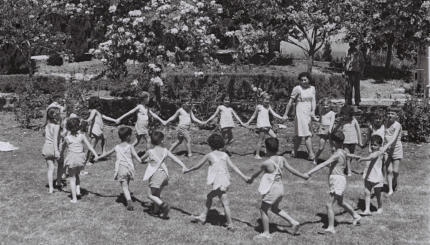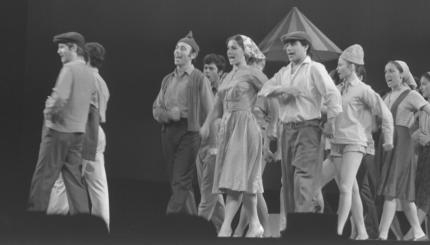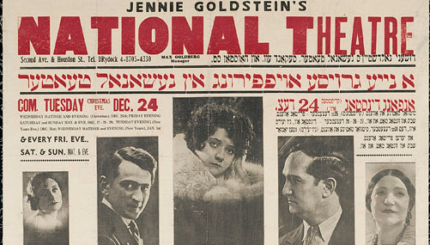In one of the most dramatic moments in the Bible, Judah boldly confronts the prince of Egypt, who has just accused Benjamin of grand larceny. Judah, still unaware the prince he is talking to is his brother Joseph, desperately begs him not to incarcerate Benjamin: “For how shall I go up to my father without the lad, lest I see the evil that will overtake my father?” (Genesis 44:34).
An artistic representation of the suspenseful scene in Andrew Lloyd Webber’s and Tim Rice’s Joseph and the Amazing Technicolor Dreamcoat adds a multicultural and playful tone. “Oh no, not he. How can you accuse him is a mystery. Save him. Take me. Benjamin is straighter than the tall palm tree,” sings the chorus of brothers in the song “Benjamin Calypso.” The brothers, morphing into whimsical Caribbean dancers with accents to boot, claim that their younger brother is “honest as coconuts,” and try to convince the prince that they are to blame: “Sure as bananas need the sun, we are the criminal guilty ones.”
Not only does the technicolor Joseph script change the tone of the biblical narrative; it also invokes artistic license and modifies several important details. But the play, which was originally written for a primary school audience in the late 1960s, and has since been performed countless times in educational settings and on Broadway, mostly conveys the narrative thrust of one of the greatest stories of parental favoritism, sibling rivalry, and rags to riches.
What is a Technicolor Dreamcoat?
According to Genesis 37:3, Jacob made Joseph a k’tonet pasim because he loved him more than any of his other sons. K’tonet is the same word used to depict the fur garments that Adam and Eve used to clothe themselves when they realized, post-sin, that they were naked, and it is the same root used to describe the High Priest’s robe. Coat is a valid translation, but pasim is a harder term to define.

Help us keep Jewish knowledge accessible to millions of people around the world.
Your donation to My Jewish Learning fuels endless journeys of Jewish discovery. With your help, My Jewish Learning can continue to provide nonstop opportunities for learning, connection and growth.
According to the medieval French commentator Rashi, the word refers to the garment’s woolen material. Rashi cites references to karpas (wool) in Esther 1:6 and to a k’tonet pasim, a woolen coat, in Samuel 2, 13:18. A midrash that Rashi cites claims the word is an acronym for Joseph’s troubles: Being sold as a slave to Potiphar in Egypt by the Sokharim (merchants), Ishmaelites, and Midyanites (thus PSIM). Nowhere does Rashi suggest the coat was colorful.
According to Genesis, Joseph’s father actually made the coat himself. However, in the song “Joseph’s Coat,” the narrator sings, “Jacob wanted to show the world he loved his son. To make it clear that Joseph was the special one. So Jacob bought his son a coat, a multi-colored coat to wear.” There is also no biblical account that backs up the play’s characterization of the coat having “golden lining” or that “a king would stop and stare.”
Surely a title like “Joseph and the Troublesome Woolen Coat” would not be the stuff of musical theater, but it would have been a title more in line with the biblical narrative.
The play also veers from the biblical account on a number of other details, confusing the order of Joseph’s brothers, mischaracterizing Joseph’s dreams, and more. Despite the play’s inconsistencies, though, it has educated many people about the biblical narrative. Rice claimed in a 1981 newspaper interview that many of those who grew up in the early 1970s also learned about the Bible from another Webber-Rice production which came after Joseph, Jesus Christ Superstar.
An Educational Operation
Joseph was originally written to educate and entertain students. A British teacher and friend of Webber’s, Alan Doggett, contacted Webber in 1967 and commissioned a 15-minute pop musical for a performance at the school where Doggett taught. Webber called Rice and asked him to write the lyrics. After rejecting stories about spies (like 007), the two young men, who were not yet famous, decided to do the biblical story of Joseph.
Webber, whose father was music director at a central London church, came from a religious background. In a 1982 interview, Rice told a reporter, “Technically I’m Church of England, which is really nothing … But I don’t follow it.” Yet, Rice told the interviewer he picked biblical narratives twice (in Joseph and Superstar) because, “I’d always rather take a true story than an untrue one.” Apparently, even though he is not a literalist, Webber at least says he believes in scripture.
In his book Geniuses of the American Musical Theatre: The Composers and Lyricists, Herbert H. Keyser says Webber and Rice later considered it “quite amusing” when people suggested they studied the Bible carefully to write Joseph. Webber said the pair devoted “about four minutes” to reading The Children’s Wonder Book of Bible Stories.
The first performance of the 15-minute play was March 1, 1968 at Old Assembly Hall at Colet Court, a school in London. About 2,500 people saw the show’s second performance, on May 12, 1968, at Westminster Central Hall, a Methodist church in London. Unbeknownst to Rice and Webber, a music critic from the Sunday Times was in attendance. The critic, Derek Jewell, gave the show a good review, which helped raise funds for future performances.
All the while, Rice and Webber expanded the show to include more and more songs.
The show was first performed on Broadway in 1982 at the Royale Theatre. A movie version of the play by Really Useful Films, starring Donny Osmond (Joseph), Maria Friedman (narrator), Richard Attenborough (Jacob), and Joan Collins (Potiphar’s wife), came out in 1999, directed by David Mallet.
Joseph & the Jews
Although some members of the Jewish community had denounced Superstar as anti-Semitic, there was no such criticism of Joseph. “‘We were accused of being anti-Jewish in Superstar by one or two extreme rabbis,’” Rice said in the 1981 interview. “‘Of course we weren’t. I think most of the people protesting didn’t really listen to Superstar. They just objected, rather, on principle to the idea of rock music being mixed up with God. Rock music has evil connotations in that context.”
Jewish audiences have embraced Joseph, which is a popular production at Jewish summer camps and schools. According to Shira Epstein, professor of education at Jewish Theological Seminary, “If you study, work in, or support Jewish camps, youth groups, day schools, or retirement homes, chances are that at some point in your lifetime you will play a part or be forced to hold a camcorder for two hours during this telling of one of the most famed Genesis narratives.” At age 13. Epstein was cast in two different versions of Joseph.
Jewish youth have performed the play in Hebrew translation. Rabbi Ruth Gan Kagan, founder and spiritual leader of the Jerusalem-based “prayer and study community” Nava Tehila, has set the songs from the Friday night Kabbalat Shabbat service to tunes from Joseph.
The many who have fallen in love with Joseph don’t seem to care that the theatrical version diverges from the Genesis story. Ultimately, the play’s prologue, no doubt aimed at students, also rings true biblically. “We all dream a lot, some are lucky, some are not. But if you think it, want it, dream it, then it’s real,” sings the narrator. “You are what you feel. But all that I say can be told another way. In the story of a boy whose dream came true.” Joseph indeed earns the nickname his brothers give him in Genesis 37:19: baal ha’halomet, the custodian of dreams.


